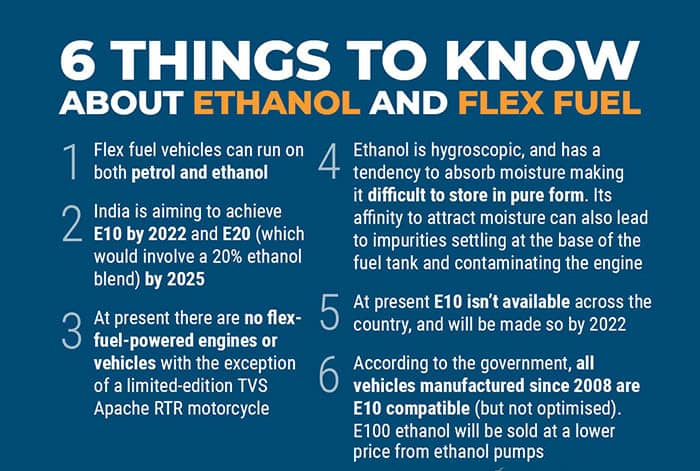Biodiversity & Environment
Flex Fuel Vehicles
- 29 Dec 2021
- 5 min read
For Prelims: Flex Fuel Vehicles (FFV) , Flex Fuel Strong Hybrid Electric Vehicles (FFV-SHEV), BS-6 Norms, Production Linked Incentive (PLI) scheme.
For Mains: Flex Fuel Vehicles: Significance and its usage, Green model of development.
Why in News
Recently, the Government has advised the Automobile Manufacturers in India, to start manufacturing Flex Fuel Vehicles (FFV) and Flex Fuel Strong Hybrid Electric Vehicles (FFV-SHEV) complying with BS-6 Norms in a time bound manner.
Key Points
- About FFV and FFV-SHEV:
- Flex-fuel vehicles (FFV): They have engines that can run on flexible fuel — a combination of petrol and ethanol, which can include up to 100% ethanol.
- Flex Fuel Strong Hybrid Electric Vehicles (FFV-SHEV): When FFV is integrated along with strong hybrid electric technology, it is referred as FFV-SHEVs.
- Strong hybrid is another term for full hybrid vehicles, which have the capability to run solely on either electric or petrol modes.
- In contrast, mild hybrids cannot run purely on one of these modes and use the secondary mode merely as a supplement to the main mode of propulsion.
- In order to accelerate the introduction of FFVs, the Production Linked Incentive (PLI) scheme has included automobile and auto components of flex fuel engines.
- Significance of the Move:
- Easing Pressure on Import Bill: The policy is expected to reduce the demand for petroleum products.
- India presently imports more than 80% of its petroleum requirement, and this also represents one of the biggest outflows of money from the country.
- Benefiting Farmers: The wide uptake of ethanol or methanol as a fuel is intended to create an additional revenue stream for farmers.
- This will provide direct benefits to farmers and help in doubling the farmer’s income.
- Boost to Atma Nirbhar Bharat: It is in line with Prime Minister’s vision of Atma Nirbhar Bharat and government’s policy on promoting ethanol as a transport fuel.
- Reducing Greenhouse Gas & Tackling Climate Change: This move will drastically reduce greenhouse gas emissions from vehicles on a well-to-wheel basis.
- Thereby, helping India to comply with its commitment made at Conference of parties (COP26) to reduce the total projected carbon emissions by one billion tonnes by 2030.
- Easing Pressure on Import Bill: The policy is expected to reduce the demand for petroleum products.
- Related Government Initiatives:
BS-VI Fuel Norms:
- The Bharat Stage (BS) are emission standards instituted by the Government of India to regulate the output of air pollutants from motor vehicles.
- India directly shifted from BS-IV to BS-VI norms. The switch to BS-VI vehicles was to happen in 2022 but looking at the poor air condition, the move was advanced by four years.
- In BS-VI fuel, the volume of Particulate Matter 2.5 ranges from 20 to 40 micrograms per cubic metre whereas in BS-IV fuel it is up to 120 micrograms per cubic metre.
- BS-VI fuel will bring down sulphur content by 5 times from the current BS-IV levels. It has 10 ppm of sulphur as against 50 ppm in BS-IV.
- Sulphur in the fuel contributes to fine particulate matter emissions. High sulphur content in the fuel also leads to corrosion and wear of the automobile engine.
- With BS-VI fuel, for every one kilometre, a car will emit 80% less particulate matter and nearly 70% less nitrogen oxide.
- Air pollutants in BS-VI fuel are much less as compared to BS-IV fuel.
- BS-VI norms also seek to reduce the level of certain harmful hydrocarbons in the emissions that are produced due to incomplete combustion of fuel.





